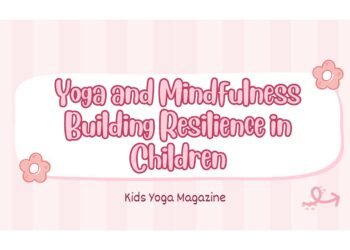In a world filled with constant distractions, pressures, and fast-paced activities, teaching children mindfulness is an invaluable way to help them navigate life’s challenges with calm and focus. Mindfulness helps children develop emotional resilience, improve concentration, and cultivate a sense of inner peace. By incorporating mindfulness into your child’s daily routine, you can provide them with the tools they need to manage stress and maintain a balanced, happy life. Here’s how you can seamlessly integrate mindfulness into your child’s everyday activities.
1. Start the Day with Mindful Breathing
The way your child begins their day can set the tone for the rest of it. Introducing a simple mindful breathing exercise each morning can help them start the day with clarity and calm.
- How to Do It:
- As soon as your child wakes up, have them sit comfortably in bed or on the floor.
- Ask them to close their eyes and take a few deep breaths in through the nose and out through the mouth.
- Encourage them to focus on the sensation of the breath entering and leaving their body, noticing how it feels to fill their lungs and then release the air.
- Spend just a few minutes on this exercise, helping them center their thoughts before the day begins.
Benefits: Starting the day with mindful breathing helps your child set a positive, focused intention for the day, reducing stress and promoting a calm mindset.
2. Incorporate Mindfulness into Daily Routines
Daily routines like brushing teeth, getting dressed, or eating breakfast provide perfect opportunities to practice mindfulness. By bringing attention to these seemingly mundane activities, your child can learn to be present and fully engaged in the moment.
- Mindful Teeth Brushing: Encourage your child to focus on the sensations of brushing their teeth—how the bristles feel against their gums, the taste of the toothpaste, the sound of the brush moving back and forth. This simple practice turns a routine task into a moment of mindfulness.
- Mindful Dressing: As your child gets dressed, ask them to pay attention to the texture of their clothes, the colors, and how each item feels as they put it on. This practice helps them stay grounded and aware of their body.
Benefits: Incorporating mindfulness into everyday routines helps children develop a habit of being present, reducing anxiety and improving focus throughout the day.
3. Practice Mindful Eating
Mealtime is another excellent opportunity to teach mindfulness. Mindful eating encourages children to slow down, savor their food, and appreciate the nourishment they are receiving.
- How to Do It:
- During meals, ask your child to take a moment to observe their food before eating. What colors do they see? What does the food smell like?
- Encourage them to take small bites and chew slowly, paying attention to the taste, texture, and sensations in their mouth.
- Ask them to think about where the food came from and the effort that went into preparing it, fostering gratitude and awareness.
Benefits: Mindful eating not only helps children develop a healthy relationship with food but also teaches them to appreciate the present moment, making mealtime a more meaningful experience.
4. Introduce Mindful Walking
Walking is an everyday activity that can be transformed into a mindfulness practice. Whether walking to school, in the park, or around the house, mindful walking helps children connect with their bodies and the world around them.
- How to Do It:
- As you walk with your child, ask them to pay attention to the sensation of their feet touching the ground with each step.
- Encourage them to notice their surroundings—the sounds they hear, the smells in the air, the feel of the wind on their skin.
- If you’re walking in nature, ask them to observe the plants, trees, or animals they see along the way, cultivating a sense of wonder and connection to nature.
Benefits: Mindful walking helps children develop awareness of their environment and their own physical presence, promoting relaxation and reducing stress.
5. Create a Bedtime Mindfulness Routine
Bedtime is a perfect time to incorporate mindfulness, helping your child wind down and prepare for a restful night’s sleep. A mindful bedtime routine can include a combination of breathing exercises, gentle stretches, and relaxation techniques.
- Mindful Breathing: Have your child lie down in bed and close their eyes. Guide them through a simple breathing exercise, such as counting breaths or focusing on the rise and fall of their belly.
- Body Scan: Guide your child through a body scan, asking them to mentally “scan” their body from head to toe, noticing any areas of tension and consciously relaxing them.
- Gratitude Practice: Before falling asleep, ask your child to think of three things they are grateful for that day. This practice helps end the day on a positive note, fostering a sense of contentment and peace.
Benefits: A mindful bedtime routine helps children transition smoothly from the day’s activities to sleep, promoting better sleep quality and emotional well-being.
6. Use Mindfulness Tools and Resources
There are many tools and resources available to help teach mindfulness to children. Mindfulness apps, guided meditations, and yoga practices specifically designed for kids can make mindfulness more accessible and fun.
- Mindfulness Apps: Consider using mindfulness apps designed for children, which offer guided meditations, breathing exercises, and mindfulness games that are easy to follow and engaging.
- Mindful Journaling: Encourage your child to keep a mindfulness journal where they can reflect on their day, note how they felt, and record any mindfulness practices they did. This helps reinforce the habit of mindfulness and provides a creative outlet for their thoughts and emotions.
Benefits: Mindfulness tools and resources provide structured guidance and variety, making it easier for children to learn and practice mindfulness in a way that suits their interests and needs.
7. Be a Mindful Role Model
Children learn by observing the adults around them. By practicing mindfulness yourself, you can model the behaviors and attitudes you want to instill in your child. Incorporate mindfulness into your own daily routine, and share your experiences with your child.
- How to Do It:
- Practice mindful breathing, walking, or eating with your child, showing them how you focus on the present moment.
- Share how mindfulness helps you manage stress, make decisions, or appreciate life’s simple pleasures.
- Encourage open conversations about mindfulness and how it can be a helpful tool in various situations.
Benefits: When children see mindfulness being practiced by their parents or caregivers, they are more likely to embrace it themselves, understanding its value and impact on daily life.
Conclusion
Incorporating mindfulness into your child’s daily routine is a powerful way to help them develop focus, emotional resilience, and a sense of inner peace. By introducing simple practices like mindful breathing, eating, walking, and a bedtime routine, you can help your child cultivate mindfulness in a way that is natural and enjoyable. Over time, these practices will become an integral part of their life, providing them with the tools they need to navigate the challenges of growing up with calmness and confidence. By being a mindful role model and using available resources, you can support your child on their journey toward a more mindful, balanced life.











